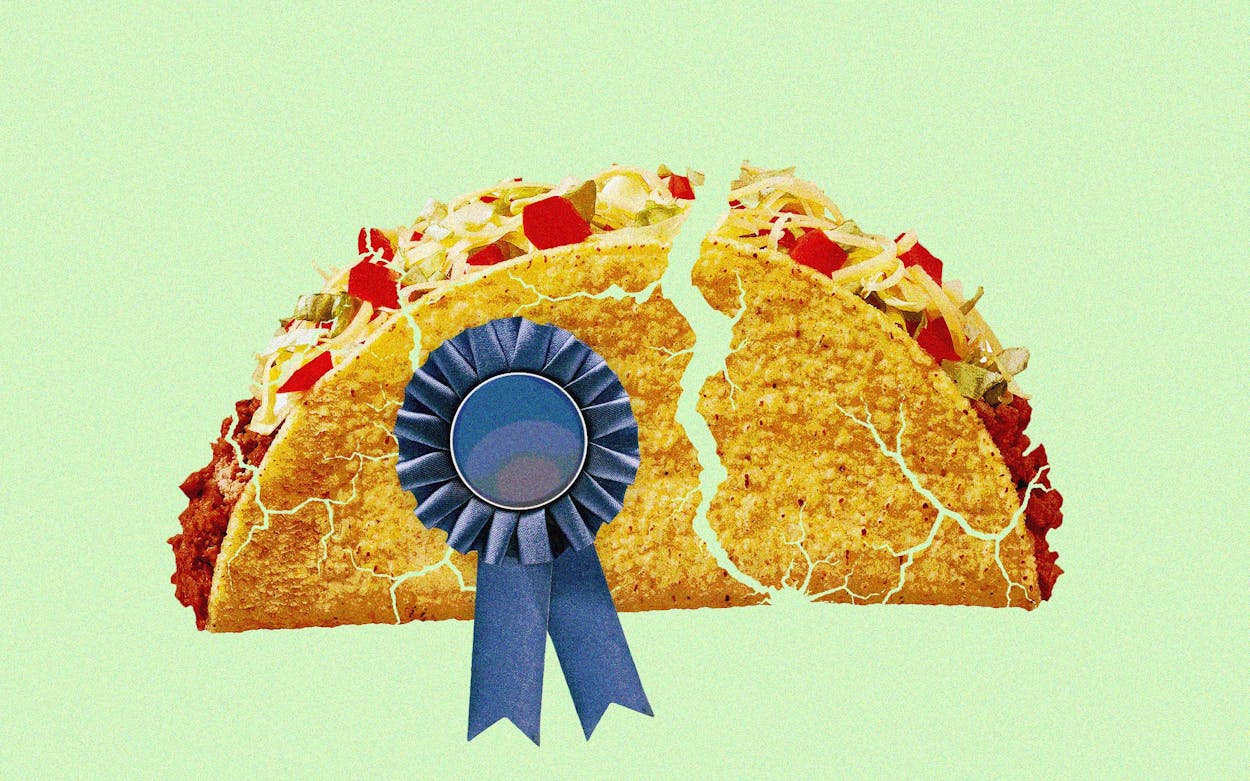The internet thrives on listicles and we—as people on the internet—are generally suckers for them. Their clickbait-y headlines are perfect for sharing on social media, driving web traffic, and creating buzz. And Texans take any opinions or data points on tacos personally, making them perfect targets for these lists. That’s why “The Best Taco Cities in America: 2023 Data,” a ranking of the top fifty metropolitan areas published last week by a real estate website, is drawing a lot of attention.
The results of the Real Estate Witch/Clever Real Estate survey claim Austin is the country’s number-one taco city. It’s puzzling why a real estate company is ranking tacos in the first place, but part of its content strategy is to cover trends in places people want to move to—thus, tacos and Texas. The study used data aggregated from Google Trends, Yelp, and the U.S. Census, and measured taco restaurants per 100,000 residents, average Yelp star rating, and taco restaurants per square mile, among other criteria. It ultimately determined the tenth-largest city in the country is the best taco city in the nation. (You can read the full methodology and results here.)
Other ranked cities include Chicago (number 24), Dallas (number 20), Houston (number 10), Los Angeles (number 6), and San Antonio (number 4). Anyone who has traveled extensively across the state and country eating tacos—like me, for example—would look at the rankings with a raised eyebrow. The list is dubious, and the findings stink of confirmation bias and confusion.
Szamor Williams, the Keller-based chief strategy officer of statistical consulting firm Precision Consulting, agrees. “It sounds like it’s just a website hosting website things,” he told me during a phone interview. The results of the study should be viewed with skepticism because they’re not specific enough. “One of the difficulties with a statement like that is that it’s so general it can easily be defended because it’s so broad,” Williams says.
To prove his point, the strategist asked, “What is a taco?” He continued, “If you define a taco based on your love of Taco Bell, then it’s easily argued Austin has the most tacos that remind you of Taco Bell.” The Clever study defines a taco roughly by the cost of a handful of ingredients, which was also used to determine the rankings. In this case, the study took into account one pound each of beef, cheese, chicken, lettuce, tomato, and onion. Not exactly what most Texans would define as a taco. The generalities could just as easily apply to more gourmet tacos. “You can say Austin has more mom-and-pop taco spots that have their own recipes than anywhere else in the country—nothing to do with [the quality of] tacos,” Williams added.
Maybe Austinites like margaritas more, and they just happen to order tacos with their drinks. Then they post or search Yelp or Google reviews where the taco is mentioned, but is really secondary to the stellar margarita. These types of reviews were translated by the Clever study into a variable called “taco passion.” How do you measure something so intangible? What does “taco passion” really mean? I’m passionate about tacos, but I’ve never written a Yelp review or anything remotely resembling one. If you’re reading this, I reckon you have a taco passion of some sort, to which I say, “Welcome, brothers and sisters.” In case you were wondering, the study ranked San Antonio as the city with the most taco passion.
When asked about the study’s findings via email, Clever Real Estate writer Sam M. Huisache, an Austin-based Rio Grande Valley–native, responded: “It’s not easy trying to compile objective data about something as subjective as food, but we try.” Great! Perhaps an A for effort is warranted. Or maybe not.
There are hidden variables not defined in the study. For example, by measuring data on “taco restaurants,” do the authors include taco trucks, trailers, gas station counters, and full-service restaurants? As for the U.S. Census data used, how is it broken down? Does ethnicity or race figure into “the cost of making tacos once a week for a year as a percentage of median household income,” or access to the internet to leave Google and Yelp reviews?
Hispanics make less than their white counterparts, according to the U.S. Census data. The median household income of “Whites, not Hispanic” as of 2020 is $74,912, while “Hispanic, any race” is $55,321. Meanwhile, Hispanics (67 percent) are less likely to use a laptop or desktop computer at home than citizens identifying as white (80 percent), according to the Pew Research Center. They have equal use of smartphones, at 85 percent. Use of all devices and broadband shows a starker picture. Whites account for 42 percent of total use compared to 35 percent of Hispanics.
All of this is to say the study is as impalpable as property values are, whereas the taco is something one can grasp. Folks from all walks of life across the country and the state enjoy and make tacos of all sorts. So, instead of unconvincingly deciding who has the “best tacos,” how about we reach for the nearest tacos, nod in respect to each other, and enjoy our tacos together.
- More About:
- Tacos








